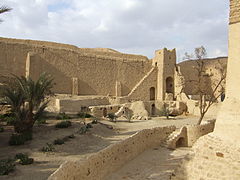- Monastery of Saint Paul the Anchorite
-
The Monastery of Saint Paul the Anchorite in Egypt is a Coptic Orthodox monastery located in the Eastern Desert, near the Red Sea mountains. It is about 155 km (96 mi) south east of Cairo. The monastery is also known as the Monastery of the Tigers.
Contents
Foundation and history
The Monastery of Saint Paul the Anchorite dates to the fifth century AD. It was founded over the cave where Saint Paul the Anchorite lived for eighty years. The first travel narrative of the monastery was provided by Antoninus Martyr, a native of Placentia, who visited the tomb of Saint Paul the Anchorite between the years 560 and 570 AD. The first monks to occupy the monastery may have been Melkites, but they were followed by Egyptian and Syrian monks. The Syrians may have had a sustained existence at the monastery, for it appears that they also occupied the monastery during the first half of the fifteenth century, after which their presence disappeared. According to an isolated Ethiopian reference, the 70th Coptic Orthodox Pope, Pope Gabriel II (1131-1145 AD), was banished to the monastery of Saint Paul the Anchorite for three years.
Like most of Egypt's monasteries, this one suffered repeatedly at the hands of Bedouin tribes. The most destructive of their raids was in 1484 AD, when many of the monastery's monks were killed and the library was put to the torch. The monastery was later rebuilt under the patronage of Pope Gabriel VII of Alexandria (1526 - 1569 AD), who sent ten monks from the Syrian Monastery to populate the monastery of Saint Paul the Anchorite. During the second half of the sixteenth century, the monastery was again attacked and ransacked twice by the Bedouins, forcing the monks to finally leave. The monastery remained deserted for the following 119 years, only to be repopulated by a group of monks from the Monastery of Saint Anthony under the patronage of Pope John XVI of Alexandria (1676 - 1718 AD), who promoted an extensive reconstruction of the monastery in 1701 AD.
Modern history
The modern monastery has three different churches. That of Saint Paul the Anchorite, built underground, was originally dug into the cave where the saint lived and where his remains are kept. The two other churches are named after Saint Mercurius and Archangel Michael. The monastery is surrounded by high walls, built during the eighteenth and nineteenth centuries. It also has a tower (keep), an ancient refectory, a mill, and a spring that is believed to have served Saint Paul the Anchorite during his eighty years of seclusion in this area. A second spring, known as the Pool of Mary is named after Mary, the sister of Moses, who is believed to have washed her feet there during the Exodus. This monastery has many illustrated manuscripts, including the Coptic version of the Divine Liturgy and the Commentary of the Epistle to Titus by Saint John Chrysostom[1]. Coordinates: 28°50′39″N 32°32′39″E / 28.84403°N 32.54425°E
Current abbot
The current abbot of the monastery is His Grace Bishop Daniel.
See also
- Coptic Orthodox Church
- Monastery of Saint Anthony
- Saint Paul the Anchorite
References
- Oxford Dictionary of Saints, ed D. H. Farmer. Oxford University Press, 2004.
- "Coptic Synexarium"
External links
Upper Egypt: 
Middle Egypt: Monastery of Saint ParsomaLower Egypt: Eastern Desert: Scetes: Monastery of Saint Macarius the Great · Monastery of Saint Pishoy · Paromeos Monastery · Syrian MonasterySinai: Categories:- Christian monasteries in Egypt
- Coptic Orthodox monasteries
- Oriental Orthodox congregations established in the 5th century
- Christian monasteries established in the 5th century
Wikimedia Foundation. 2010.

